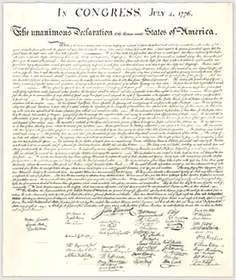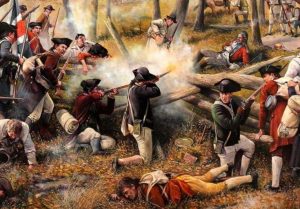
 Most of us think of everything changing instantly when the Declaration of Independence was signed, and officially it did, but there was more to it than that. After years of oppression under the rulership of the British, the citizens of the 13 colonies had had enough. They formed the Continental Congress. The term “Continental Congress” most specifically refers to the First and Second Congresses of 1774–1781 and, at the time, was also used to refer to the Congress of the Confederation of 1781–1789, which operated as the first national government of the United States until being replaced under the Constitution of the United States. The 56 delegates to the Second Continental Congress represented the 13 colonies, 12 of which voted to approve the Declaration of Independence on July 4, 1776…our accepted day of Independence. The signing of the United States Declaration of Independence actually occurred on August 2, 1776, at the Pennsylvania State House in Philadelphia, which later to become known as Independence Hall. I suppose that a purist might insist that August 2nd should be our Independence Day, but the 56 delegates to the Second Continental Congress felt like once it was agreed upon, it was done. The signing was merely a technicality.
Most of us think of everything changing instantly when the Declaration of Independence was signed, and officially it did, but there was more to it than that. After years of oppression under the rulership of the British, the citizens of the 13 colonies had had enough. They formed the Continental Congress. The term “Continental Congress” most specifically refers to the First and Second Congresses of 1774–1781 and, at the time, was also used to refer to the Congress of the Confederation of 1781–1789, which operated as the first national government of the United States until being replaced under the Constitution of the United States. The 56 delegates to the Second Continental Congress represented the 13 colonies, 12 of which voted to approve the Declaration of Independence on July 4, 1776…our accepted day of Independence. The signing of the United States Declaration of Independence actually occurred on August 2, 1776, at the Pennsylvania State House in Philadelphia, which later to become known as Independence Hall. I suppose that a purist might insist that August 2nd should be our Independence Day, but the 56 delegates to the Second Continental Congress felt like once it was agreed upon, it was done. The signing was merely a technicality.
For the British government, neither of those days was acceptable, nor was the day they found out about the plan of the 13 colonies to gain their independence. In fact, that day…August 10, 1776, was the least acceptable day of all, because the British had no intention of giving the Colonies their independence…not without a fight anyway. When the news reached London, the British saw the conflict, centered in Massachusetts, as a local uprising within the British empire. Some Americans saw it that way too, but the reality is that the Declaration of Independence transformed the 13 British colonies into American states. King George III saw it as a colonial rebellion, but the Americans saw it as a struggle for their rights as British citizens. However, when Parliament continued to oppose any reform and remained unwilling to negotiate with the American rebels and instead hired Hessians, German mercenaries, to help the British army crush the rebellion, the Continental Congress began to pass measures abolishing British authority in the colonies. It was a brave move that would cost many of the 56 signers more than they could ever have imagined.
Following the signing of the Declaration of Independence, five of the signers were captured by the British and labeled as traitors. They were tortured before they died. Twelve of them had their homes ransacked and burned. Two lost their sons, who served in the Revolutionary War. Another two had sons captured, and nine of the 56 fought and died from wounds or hardships of the Revolutionary War. These men knew the risks they were taking. They knew that signing the Declaration of Independence very likely would cost them their lives. Nevertheless, they also knew that they couldn’t let the tyranny continue any longer. They had come to America to escape the tyrannical British government, and they could not allow the British government to make them slaves again. They signed, knowing they would likely die, but they saw no other way. These men weren’t soldiers…so, who were they. Twenty-four were lawyers and jurists. Eleven were merchants. Nine were farmers and plantation owners. All of them were men of means and well-educated, but they signed the Declaration of 
 Independence, knowing that the penalty would be death if they were captured. These men had their livelihood threatened and destroyed, their homes confiscated and sold, and some were threatened so badly that they had to constantly move their families from place to place. Still, not one of them saw this as one option of many. When it came to taking their country back, they saw it as the only option.
Independence, knowing that the penalty would be death if they were captured. These men had their livelihood threatened and destroyed, their homes confiscated and sold, and some were threatened so badly that they had to constantly move their families from place to place. Still, not one of them saw this as one option of many. When it came to taking their country back, they saw it as the only option.


Leave a Reply